The Absolute Best New Zealand Road Trip Route:
- Stop 1: Auckland
- Stop 2: Waiheke Island
- Stop 3: Matakana & Omaha Beach
- Stop 4: Bay of Islands
- Stop 5: Cape Reinga
- Stop 6: Waipu Caves (Glow Worms)
- Stop 7: Hot Water Beach
- Stop 8: Mount Maunganui
- Stop 9: Hobbiton
- Stop 10: Rotorua
- Stop 11: Lake Taupo
- Stop 12: Tongariro Alpine Crossing
- Stop 13: Hawke’s Bay
- Stop 14: Wellington
- Stop 15: Marlborough
- Stop 16: Kaikōura
- Stop 17: Christchurch
- Stop 18: Lake Tekapo
- Stop 19: Lake Pukaki
- Stop 20: Aoraki / Mount Cook
- Stop 21: Queenstown
- Stop 22: Glenorchy
- Stop 23: Milford Sound / Piopiotahi
- Stop 24: Arrowtown
- Stop 25: Lake Wānaka
- Stop 26: Fox Glacier & Franz Josef Glacier
- Stop 27: Hokitika Gorge
- Stop 28: Abel Tasman National Park
- Stop 29: Nelson

Stop 1: Auckland
Most international flights to New Zealand arrive in Auckland, so it’s the ideal first stop on your New Zealand road trip.
If you’re going to be doing your New Zealand road trip in a car, campervan or RV, I would recommend picking this up when you leave Auckland (after Waiheke Island) because parking in the city can be costly.
Auckland is the largest city on the North Island, based around two large harbours.

I would recommend spending 2 nights here to visit the Sky Tower, Auckland War Memorial Museum, Viaduct Harbour and Mount Eden, as well as great food and drink in the hip Ponsonby neighbourhood.
Also, be sure to check out some of Auckland’s great breweries.
Stop 2: Waiheke Island
Waiheke Island is a pristine spot just off the coast of Auckland, which has been named one of the most beautiful islands in the world.
As well as being home to wonderful beaches, Waiheke Island is also a wine-producing region with great vineyards to visit.
The best vineyards on Waiheke Island are Tantalus Estate, Te Motu Vineyard and Man O’ War Vineyards (or you could join a wine tour to see even more in one day).


Not a fan of wine? You can spend your day on Waiheke exploring world famous beaches like Onetangi Bay (great sunsets) and Palm Beach.
To get to Waiheke Island, you need to catch the ferry from Downtown Auckland, Devonport or Half Moon Bay (vehicle crossings available).
Once on the island, you can catch public transport around the island or use the Hop-On Hop-Off Explorer Bus Tour.
After leaving Auckland/ Waiheke Island it’s worth heading a few miles west to check out black-sand Piha Beach with its impressive rugged landscape.
Stop 3: Matakana & Omaha Beach
Your next stop on your New Zealand road trip is the stunning Matakana Coast, less than 1 hour north of Auckland.
The small town of Matakana has become a trendy getaway destination for Aucklanders in recent years, offering great breweries, artisan food and boutiques.
Don’t miss the famous Matakana Village Farmers’ Market, 8 Wired Brewing Barrelworks, Matakana Oysters, The Vintry Wine Bar and Fired Pizza Company.
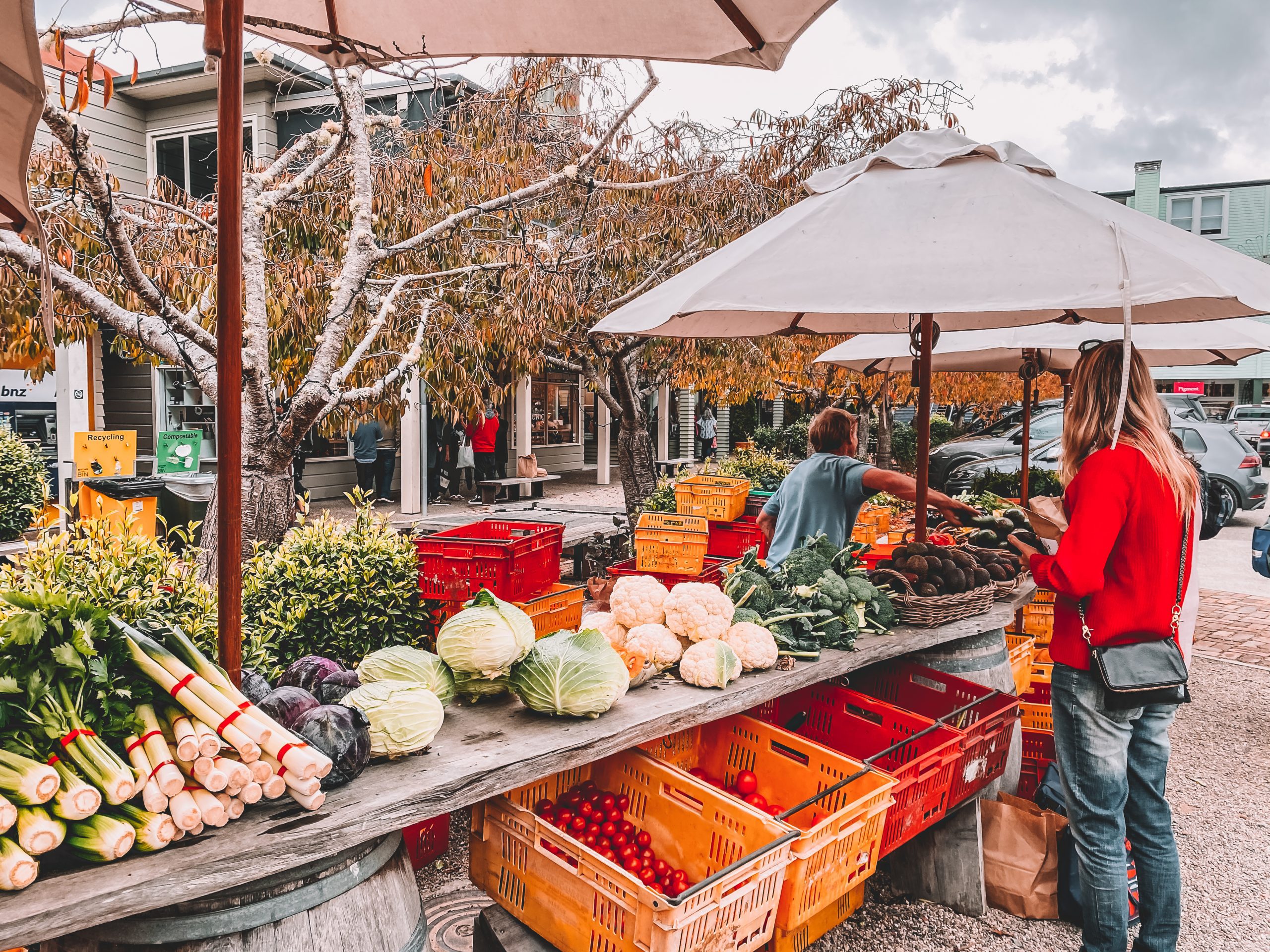
After enjoying a couple of hours in Matakana, you need to go to Omaha Beach.
Omaha Beach is accessed by a beautiful wooden boardwalk, and offers some of the whitest sand in New Zealand.

Whilst here, don’t miss Ti Point, a small peninsula opposite Omaha Beach with amazing turquoise blue water.
Another great beach in the area is Anchor Bay Beach which is found within Tawharanui Regional Park (this is where you can find the very rare wild kiwis using a red light torch after dark!).
Stop 4: Bay of Islands
Bay of Islands is an area made up of more than 140 subtropical islands with idyllic bays and ample marine life.

Most of the islands can only be reached by boat or yacht, meaning the beaches are unspoilt and you feel like you’re in paradise.
If you want to visit several islands you should do a full day tour which provides the opportunity to swim, snorkel, paddleboard and see dolphins.
Alternatively, if you want a cheaper option you can get the passenger ferry from Paihia to Russell ($14 return for adults).
Russell is a charming ocean-front town with colonial architecture, bright blue water and great viewpoints.
Whilst in the area I can recommend visiting the Waitangi Treaty Grounds, the protected place where the first agreement between the Māori and the British was signed.
You can also do the highest skydive in New Zealand above Bay of Islands (20,000 ft).
I can also recommend Whananaki, which is found just south of Bay of Islands, with aquamarine ocean and golden sand (Otamure Bay DOC Campsite is a fab spot to camp right on the beach).
Stop 5: Cape Reinga
Visiting Cape Reinga is a bucket-list experience on your New Zealand road trip.
Located right at the very top of the North Island, Cape Reinga is the ‘end of the road’ and culturally significant for Māori, who believe that the spirits of the dead depart to the afterlife from this point.
Cape Reinga Lighthouse marks the furthest point you can walk to, from here you can see the colliding of the Tasman Sea and the Pacific Ocean, which creates unique currents and waves.
From the lighthouse, try to spot the ‘Spirit Tree’ at the very end of the rocky tip.

After you’ve admired the northernmost point of New Zealand, check out the Giant Sand Dunes down the road.
The Giant Sand Dunes are a natural attraction of shifting sand dunes just off the Twin Coast Discovery Highway, where you can sandboard.
In high season, there’s usually a kiosk open where you can hire bodyboards.
On your way back south, I would definitely check out Waipoua Kauri Forest to see the Tāne Mahuta (New Zealand’s largest known living kauri tree/ ‘Lord of the Forest’).
Stop 6: Waipu Caves (Glow Worms)
Waipu Caves are one of New Zealand’s best kept secrets.
Found on the way back down to Auckland from the north, Waipu Caves allow you to see stunning glow worms for FREE.
The caves are open to the public and found at the edge of a field in the middle of farmland. It’s a great alternative to the Waitomo Caves further south which cost over $50 to visit!
To see the glow worms you need to enter the cave and head to the left.
Next, you have to wade through ankle-deep water for about 50 metres and you’ll be amazed by hundreds of glow worms above you lit up like stars in the night sky.

You will need waterproof boots and a torch, also take care at the start of the cave because the rocks are slippery.
If you’re up for the challenge, this is definitely a magical experience that will cost you nothing!
At the entrance to the cave there’s also a free grassy campsite with toilets.
Stop 7: Hot Water Beach
Hot Water Beach on the Coromandel Peninsula is a natural phenomenon where hot springs run underneath the sand.
This means that at certain times of the day you can dig below the sand, creating a pool of thermal water to bathe in.
You should know that you can only dig for hot water for 2 hours either side of low tide, so check the low tide times here and arrive 2 hours before.
Also, the hot water springs are only located on a specific part of the beach (in front of the small rocks in the ocean).

You can hire shovels from the café near the beach.
Visiting Hot Water Beach in the winter is great as it’s quieter and it’s like being in a hot tub!
Whilst on the Coromandel Peninsula you also need to check out Cathedral Cove for crystal blue water and kayaking, Cooks Beach and the Whenuakura Wildlife Sanctuary on Donut Island.
Stop 8: Mount Maunganui
Mount Maunganui is an extinct volcano overlooking the ocean – it’s a sacred Māori site with beautiful hiking trails (and well worth a stop on your New Zealand road trip).
The hour-long ascent to the summit is quite steep, but at the top you’ll be rewarded with epic views of the Bay of Plenty.

Whilst in Mount Maunganui, eat at Ours Cafe for breakfast/ brunch, Lolo Authentic Turkish Kitchen for lunch and Solera for dinner.
Also check out the sandy shores of Main Beach for surfing and the calm waters of Pilot Bay Beach for paddle boarding.
Stop 9: Hobbiton
The next stop on your New Zealand road trip is arguably the most famous attraction in New Zealand, and the reason why tens of thousands of visitors come every year.
The Hobbiton Movie Set, which featured in The Lord of the Rings & The Hobbit trilogies, was the chosen filming location for the fictional village of Hobbiton in the Shire, home to the Hobbits.

During the Hobbiton Movie Set Tour you’ll feel like you are actually in the LOTR movies, as the Hobbit Holes and scenery have been preserved to remain exactly as they looked in the films.
Stop 10: Rotorua
Rotorua is famous for its geothermal activity and Māori culture.
From thermal mud baths to spouting geysers and living Māori villages to explore, definitely stay overnight at Rotorua to experience it all.
The best paid geothermal experiences in Rotorua are Manupirua Springs Hot Pools.
For travellers on a budget you can visit Kerosene Creek, a natural hot springs area with a waterfall, for free.
You can witness boiling bubbling mud at Waiotapu Mud Pool for free aswell, and you should definitely visit Kuirau Park (public park with free geothermal foot baths and hot springs).

If you’re doing your New Zealand road trip in a campervan, I can highly recommend staying at Waikite Valley Thermal Pools.
The campsite costs around $30 per adult per night (kids are cheaper) and includes access to the six hot pools.
You can enjoy the hot pools throughout your stay, and get exclusive access to the pools at sunrise before the park is open to the public.
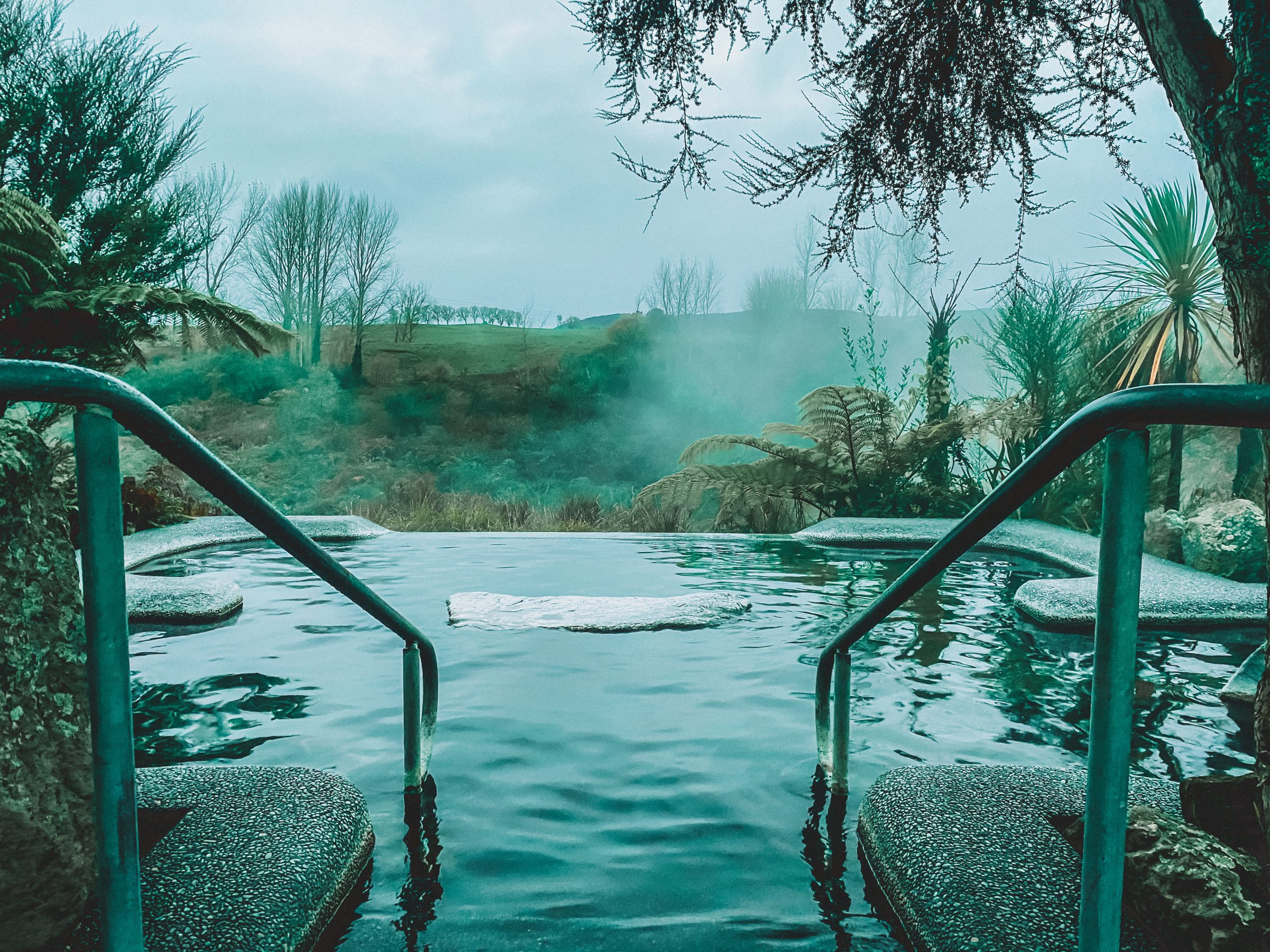
The best cultural experiences in Rotorua are Te Puia (home to the world famous Pōhutu geyser) and Whakarewarewa – The Living Maori Village.
Aside from geothermal fun, Rotorua Night Market on a Thursday is brilliant, as is the Rotorua Luge for adrenaline lovers.
Rotorua is also the best place in New Zealand to do white water rafting, with the nearby Kaituna River providing the highest rafted waterfall in the world.

After leaving Rotorua, you should also check out Waiotapu Thermal Wonderland on the way to Taupo, a cool geothermal area with bright orange and green steaming lakes.
Just so you’re aware, Rotorua is known as the ‘sulphur city’ – it’s a smelly destination with a distinct scent of rotten eggs!
Stop 11: Lake Taupo
Another big hit on the New Zealand road trip is Lake Taupo, a large crater lake found in the middle of New Zealand’s central volcanic plateau.
Huka Falls, a waterfall that drains a quarter of a million litres of water per second from the lake, is the best thing to see in Taupo.


At Huka Falls, you can experience the cascading water upclose on the HukaFalls Jet, or do the Spa Thermal Park to Huka Falls Walk to follow the flow of the Waikato River.
Another cool thing to do in Lake Taupo is watch the Aratiatia Rapids, where the Aratiatia Dam opens to release a crazy amount of water through a narrow gorge (it’s free too!).
The rapids feature in Peter Jackson’s The Hobbit, when the dwarves travel down the gorge in wooden barrels.
The dam opens daily at 10am, 12pm, & 2pm.
Alternatively, keen hikers will enjoy tackling Mt Tauhara, whose summit offers panoramic views of Lake Taupo and central North Island (the below photo looks deceiving – in reality it’s a steep 3.5 hour return tramp).

On the lake itself, visitors can enjoy water-skiing, kayaking or join a boat trip to the Māori rock carvings at Mine Bay.
Stop 12: Tongariro Alpine Crossing
Next up is the most famous hike in the whole of New Zealand, the Tongariro Alpine Crossing.
Tongariro National Park was the filming location for Mordor in the Lord of the Rings movies, and the alpine crossing lets fans do the epic journey into Middle Earth.

The 19.4 km (12 mile) one-day trek takes you through jagged volcanic rock formations and barren landscapes with emerald lakes, allowing you to get up close to Mount Ngauruhoe (Mount Doom).
In the spring and summer, fit and healthy visitors can hike the Tongariro Crossing without a guide.
There is a shuttle bus available which drops you at the start point of the trek and allows you to leave your car at the finish point.
However, when the season ends and the cold weather begins, volatile alpine conditions mean you need to join a guided tour to complete the crossing.
*After completing the Tongariro Alpine Crossing, keen hikers may want to head west to Egmont National Park and do the Mount Taranaki Summit Track/ Pouakai Crossing. Fit and well-equipped trampers can hike to the top of the mountain from December to April, but for the rest of the year it’s covered in snow and ice. This is an optional extra stop on the New Zealand Road Trip Itinerary*.

Stop 13: Hawke’s Bay
Hawke’s Bay is a wine region on the East Coast of the North Island, which also has great beaches.
There are over 70 wineries in Hawke’s Bay, set amongst rolling vineyards and green hillsides.
The big towns in Hawke’s Bay are Napier (with art-deco architecture) and Hastings, but I would personally stay around Te Awanga or Havelock North for beautiful scenery and proximity to cellar doors.
Whilst you can Uber between wineries in this area, it’s cheaper to hire a bike and follow the winery trail.
The best winery bike trail in Hawke’s Bay starts at the coastal vineyards of Te Awanga/ Haumoana before following the TukiTuki river inland to the wineries near Havelock North.

Stop 14: Wellington
Wellington is the capital city of New Zealand, and a must-do stop on your road trip.
The coastal city is home to the Te Papa Museum of New Zealand, which is free to visit and well worth spending a few hours here.
Walking up to Te Ahumairangi Hill Lookout or Mount Victoria Lookout provides the best views of the city.
Alternatively, if you don’t like walking uphill the Wellington Cable Car takes you up past the Wellington Botanic Garden to a great viewpoint in the hilly suburb of Kelburn.

The Wellington Waterfront Walk is a great way to see the best of Wellington.
Start at Queen’s Wharf and walk south along the City to Sea Bridge (with Māori carvings), before continuing past the Naked Man Statue to the marina and the beachside neighbourhood of Oriental Bay.
In the city centre, don’t miss a walk down Cuba Street to experience great art, shopping and restaurants.
Wellington is the last North Island stop on your New Zealand road trip, from here you can catch the ferry to South Island via the Cook Strait.
Stop 15: Marlborough
Once you’ve touched down in Picton on South Island, it’s time to try some wine.
Marlborough is the largest wine region in New Zealand, and famous across the globe for its mouthwatering Sauvignon Blanc.
The region encompasses several towns, but it’s best to stay in Blenheim or Renwick to be in close proximity to the wineries and vineyards.

If you fancy hiring a bike, the best way to explore the Marlborough Wine Region is on the Golden Mile, a 6km ride featuring nine wineries.
Stop 16: Kaikōura
Kaikōura is a coastal town known for its sperm whale population.
Between June-September you can join a whale watching cruise to see giant sperm whales off the coast.

Outside of these months, you can still see abundant wildlife in Kaikōura.
The Kaikoura Peninsula Walkway is a must-do activity if you want to see the Kaikoura Seal Colony (especially Point Kean Viewpoint for great views of the New Zealand fur seals up close).

Kaikōura also has some great cafés for breakfast, lunch and coffee just by the beach.
Stop 17: Christchurch
Christchurch is the biggest city on the South Island and a pretty cool place to visit for the day.
It has a lot of English heritage, which can be admired from a stroll or cycle along the River Avon.
Riverside Market is a lively spot to enjoy some street food and artisan products (the gooey Whittaker’s chocolate cookies are a must-try).
Similarly, New Regent Street is a colourful pedestrian mall with boutique stores and bars to enjoy.
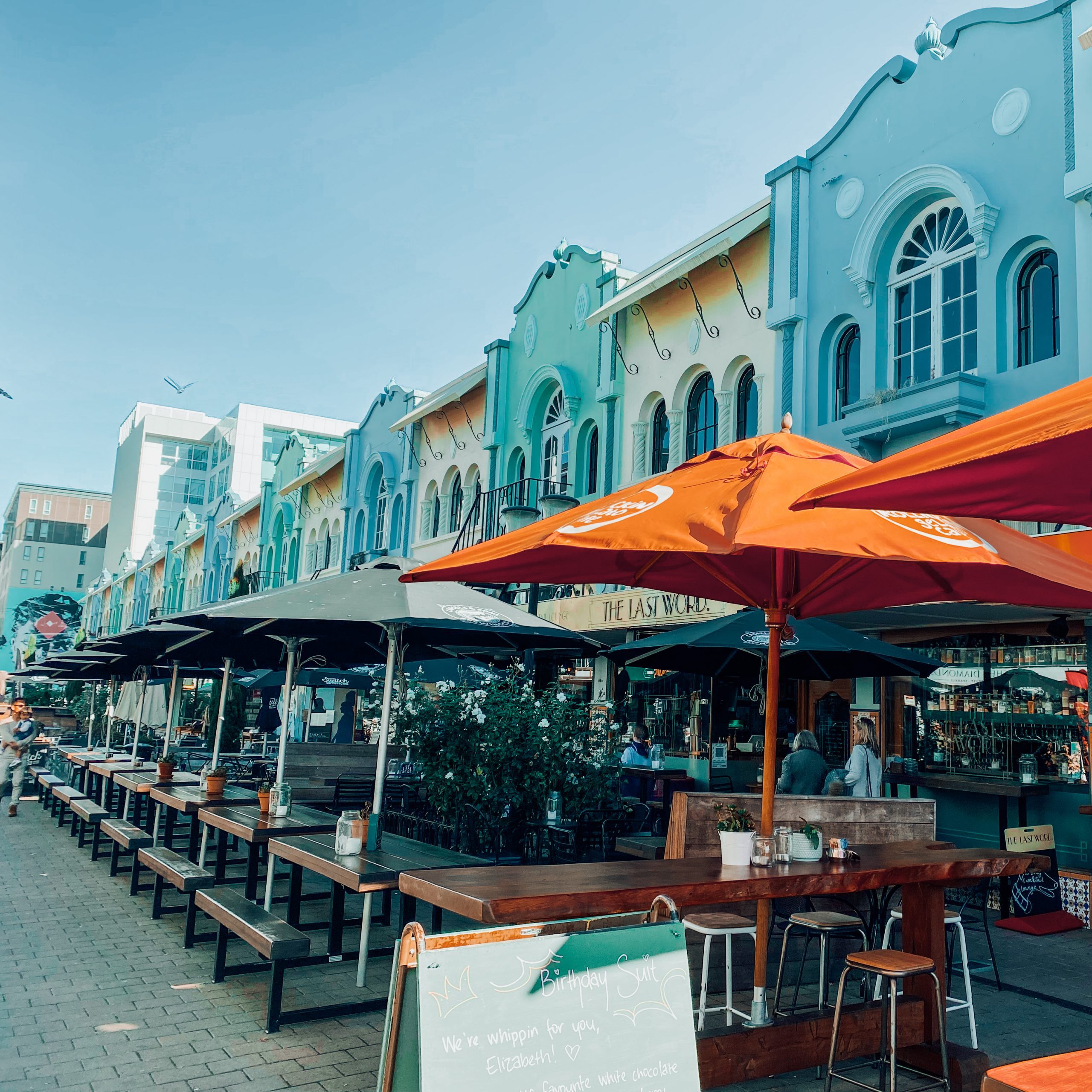
Keep an eye out for the old vintage electric trams, which still circle the city centre for tourists.
Stop 18: Lake Tekapo
One of my favourite spots in the whole of New Zealand, Lake Tekapo is absolutely magical.
The town of Lake Tekapo is small, yet it has an alpine feel with cosy restaurants and chalet-style accommodation.
The lake itself is beautiful all year round, and suitable for swimming in summer.
Don’t miss the famous Church of the Good Shepherd, an old Anglican church perched on the very edge of the lake.
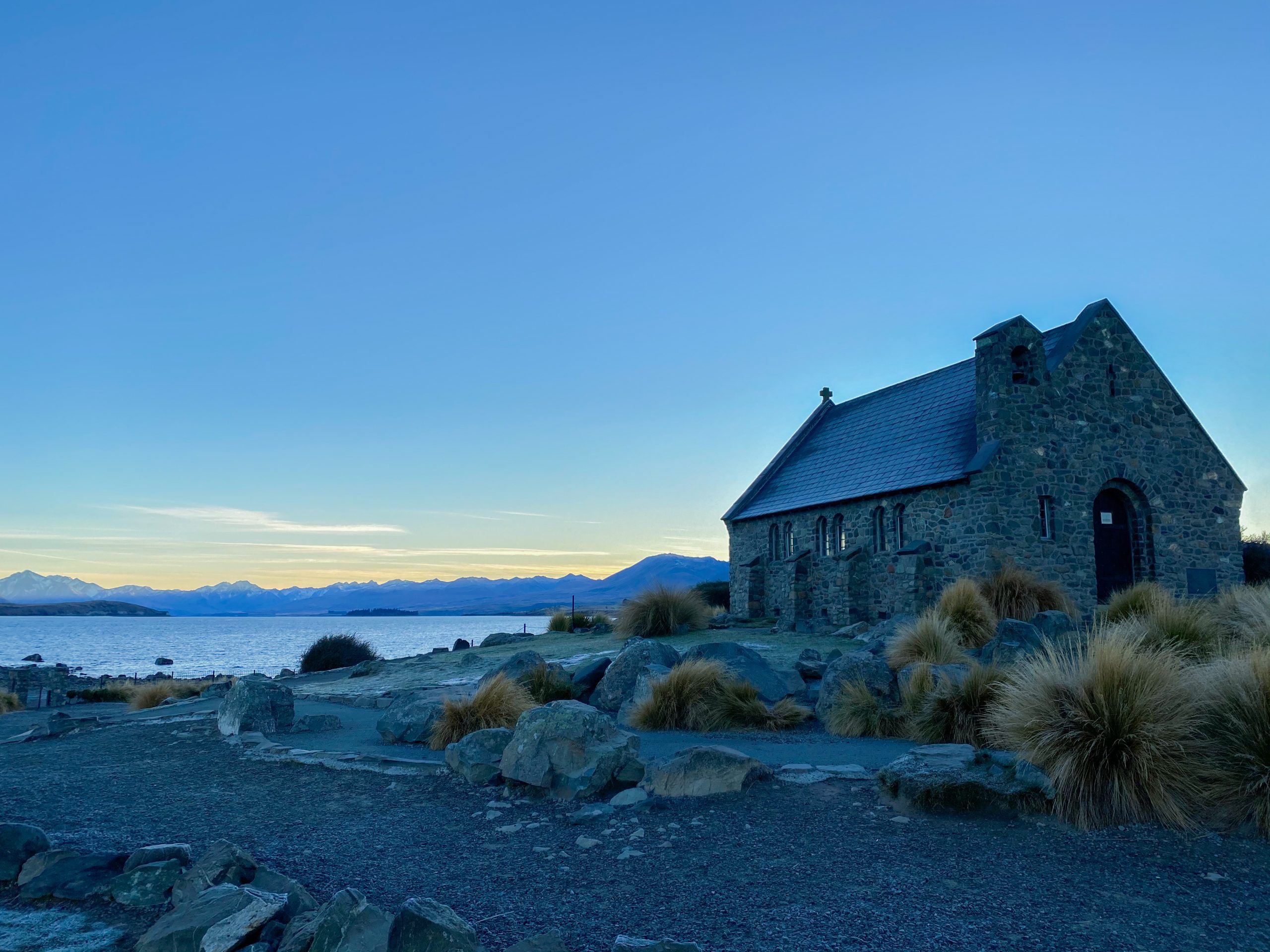
Mt John Summit Circuit Track offers panoramic views above the lake for those who enjoy a moderate hike.
There’s a really good Japanese restaurant in Lake Tekapo called Kohan which specialises in sushi, sashimi and bento boxes (reservations necessary as it’s always busy).
Stop 19: Lake Pukaki
Just a 45 minute drive from Lake Tekapo, Lake Pukaki is another brilliant alpine lake in the Mackenzie Basin on South Island.
Lake Pukaki is famous for its distinctive turquoise colour, which is caused by silt flowing down from the glaciers of the Southern Alps.

The Lake Pukaki Shoreline Walk at the southern tip of the lake is a great way to experience the lake with views of snow-capped Mount Cook in the backdrop.
Lake Pukaki is a sparsely populated area without restaurants or urban infrastructure.
It’s a good place to stop off for a few hours in between Lake Tekapo and Mount Cook.
Stop 20: Aoraki / Mount Cook
Mount Cook (Aoraki) is the highest mountain in New Zealand, and unlike anywhere I’ve ever visited before.
Some of the best hikes in New Zealand are found in Aoraki Mount Cook National Park.
The Hooker Valley Track is a fantastic walk which follows the Hooker River across swing bridges and past Lake Müller before arriving at Hooker Lake.

The Hooker Valley Track is about 2.5 hours return and relatively flat with a gravel path which winds through the Hooker Valley.
For those who love a challenge, the Sealy Tarns Track is a steep ascent up hundreds of steps to the Sealy Tarns Viewpoint.
About 3 hours return, the leg burn is so worth it when you see the view at the top.

From the view point, adventurers may want to go even further to Mueller Hut, an alpine hut 1800m above sea level where you can spend the night in bunks.
The final short walk you have to do in Aoraki Mount Cook National Park is the short walk up to the Tasman Glacier viewpoint, offering views of the icy cliffs of the glacier and Tasman Lake beneath it.
As for accommodation, there are a few lodges and chalets in Aoraki / Mount Cook Village or you can stay at the White Horse Hill Campground which is also the start of the Hooker Valley Track & Sealy Tarns Track.

If you want to splurge, you could do a ‘heli hike’ at Mount Cook, which involves a scenic helicopter ride that lands on top of the glacier for a snow hike.
There aren’t really any restaurants or cafés in the Mount Cook area, so do a supermarket run in Lake Tekapo if you’re going to stay for a couple of days.
After leaving Mount Cook, stop off in the town of Twizel on the way south for good restaurants, cafés, supermarkets and reasonably priced petrol.
Stop 21: Queenstown
Your next stop is Queenstown and one of the most popular road-trip spots in the whole of New Zealand.
Before I visited NZ part of me wondered if Queenstown was over-hyped.
I was wrong – Queenstown is a seriously magical place.
Located on the shores of the huge Lake Wakatipu, and set against the dramatic Southern Alps, Queenstown is everything you expect from New Zealand’s lakes and mountains in one town.

Whatever your pleasure, you’re sure to find it in Queenstown.
Adrenaline-junkies will love bungee jumping off Kawarau Gorge Suspension Bridge or an 85km/hour jet boat ride through the Shotover River Canyons.
Hikers enjoy the challenging climb up Queenstown Hill (don’t be fooled – it’s actually a small mountain) for panoramic views above Queenstown and the mountains/ lake beyond.
You can go further up to Ben Lomond if you want to do a full-day hike.
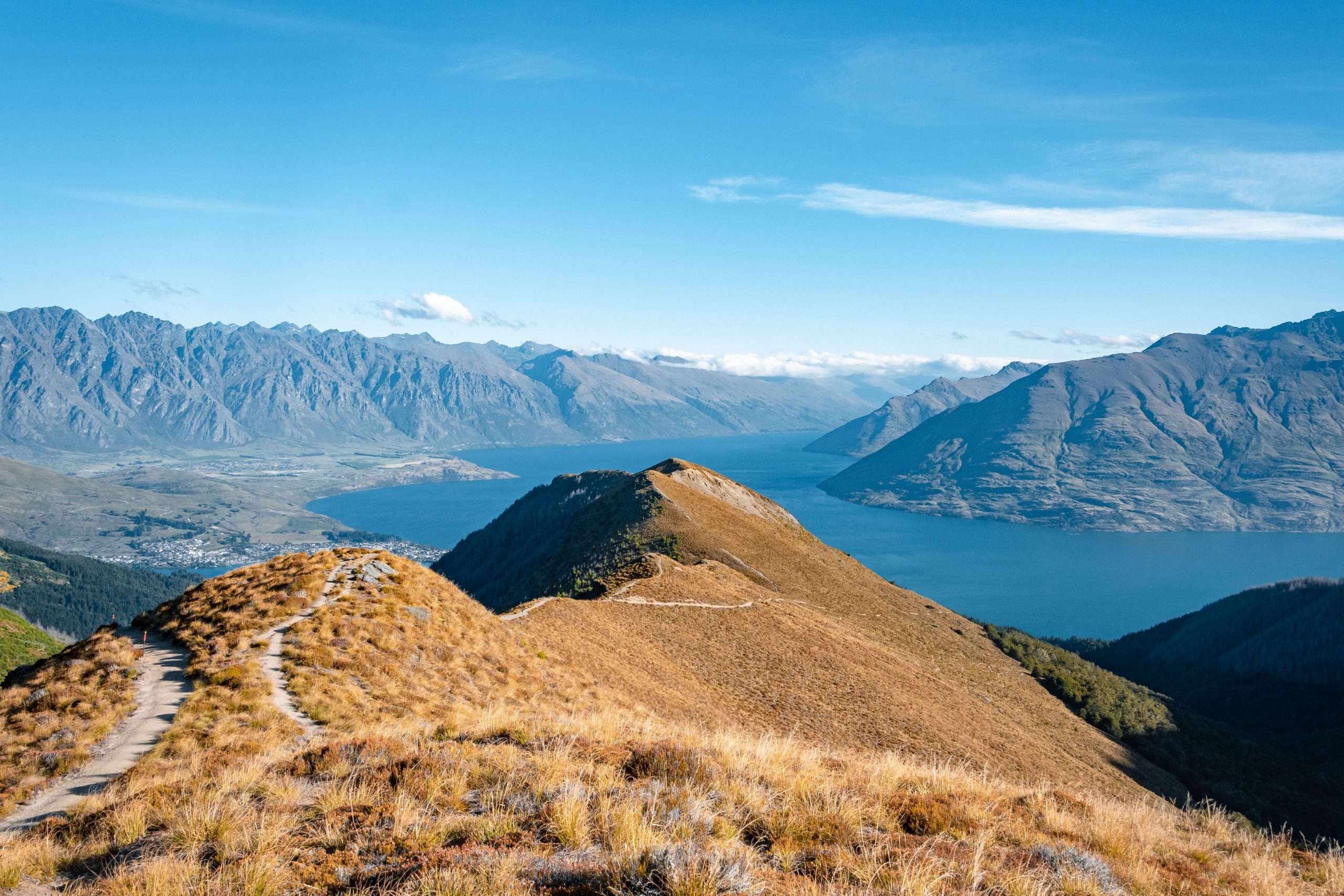
In winter, The Remarkables Ski Area is open and Queenstown becomes an alpine resort with rosy-cheeked skiers and snowboarders heading back into town in the afternoon for a spot of après-ski.
Families will love the Queenstown Luge, a fun toboggan track at the top of a mountain accessed by the Skyline Gondola.
For foodies, don’t miss Margo’s Queenstown for authentic Mexican, Blue Kanu for Polynesian-Asian fusion, The Bunker for inventive NZ dishes, and Fergburger for queue-out-the-door cult burgers.
Perky’s Floating Bar is the best spot for a drink in Queenstown.
It’s docked on Queenstown Wharf, floating on Lake Wakatipu overlooking the mountains.

Onsen Hot Pools have become a bit of an Instagram sensation in recent years, but if you can afford it, the cedar-lined hot pools overlooking the mountains are pretty special.
Stop 22: Glenorchy
Glenorchy is a small settlement at the northern end of Lake Wakatipu, about 45km from Queenstown.
Surrounded by towering snow-capped mountains, Glenorchy is well worth a visit for a couple of hours to enjoy the scenery and get epic photos.
Glenorchy Wharf is a picturesque spot to take in the dramatic landscapes of the area, complete with the iconic red shed which you’ll often see in NZ travel guides.

The Glenorchy Lagoon Scenic Walkway is a long boardwalk that meanders through lush green wetlands to take you to Glenorchy Lagoon.
During warmer weather, it’s great to enjoy a picnic on one of the many wooden benches overlooking the water.

If you really want to benefit from the peace and quiet of Glenorchy (and if you have a few pennies to spend), you could stay in the luxury Blanket Bay Lodges complete with outdoor pools and hot tubs.
Alternatively, most people just visit Glenorchy for a couple of hours and then go back to Queenstown to continue their New Zealand road trip.
Stop 23: Milford Sound / Piopiotahi
Milford Sound or Piopiotahi is a natural wonder that’s been dubbed one of the best travel destinations in the world.
Despite the name, Milford Sound is actually a fiord not a sound, meaning it was formed by the erosion of ancient glaciers over millions of years.
The result is 15 kilometres of inky-dark water surrounded by mountain peaks and sheer rock faces up to 1200m tall.

Two waterfalls cascade down the sheer cliffs, and if you go on a boat tour, they’ll take the bow up to the edge of the waterfall so you can feel the water droplets on your skin.
You have a couple of options when visiting Milford Sound, you can either drive yourself to Milford Sound and get on a boat there or get a full bus tour from Queenstown (so you don’t have to do the 7-hour return trip yourself).
By the time we arrived in Queenstown, we had already almost driven the whole length of the country on our New Zealand road trip, so we decided to get the bus tour instead.
We booked the Southern Discoveries Coach and Nature Cruise from Queenstown which involved travelling on a glass-roof coach, stopping off at points of interest along the way including Mirror Lakes, Monkey Creek and the Eglinton Valley.
You’ll also get interesting and hilarious commentary throughout the journey and we learnt so many facts about Milford Sound and South Island.
The guide is also great at spotting keas, (beautiful rare mountain parrots) – during one of our stops the kea flew over and landed on the wing mirror of the coach!

If you are driving to Milford Sound yourself, the benefit is that you can stop off in the lakeside town of Te Anau to break up the journey.
Whilst on this section of your New Zealand road trip, keen hikers may want to tackle the world-renowned Routeburn Track.
The epic 32km/ 3-day route is one of New Zealand’s Great Walks, linking Fiordland and Mount Aspiring national parks with camping spots along the way.
Stop 24: Arrowtown
After visiting Milford Sound it’s time to head north again (if you have a month or less in New Zealand and want to do both islands, I would probably leave out Dunedin/ Stewart Island).
Your next stop takes you 20 minutes north of Queenstown, to the historic gold mining area of Arrowtown.
Arrowtown is one of the most photographed heritage towns in New Zealand, and it’s especially beautiful in autumn when the trees on the surrounding hills become a curtain of golds and reds.

A walk down the high street is a must-do activity to appreciate the heritage storefronts, which date back to the 1800s.
A meander down to the gold-bearing Arrow River on the Tobins Track is picturesque, whilst keen cyclists may choose to do a section of the 120km Queenstown Trail.
Arrowtown has recently become an unlikely foodie destination, with tourists and New Zealanders travelling from afar to try the highly rated Aosta Restaurant, as well as La Rumbla, The Chop Shop Food Merchants and many others.
Stop 25: Lake Wānaka
The next stop on your New Zealand road trip is Lake Wanaka. But to get there, you need to embark on one of the most scenic (and kinda scary) drives in the country.
From Arrowtown, it’s time to cross the Crown Range on the Crown Range Road, the highest main road in New Zealand.

The memorable drive offers breathtaking views of the Central Otago region, but it can be hazardous in winter so ensure you check the weather conditions.
After you’ve conquered the Crown Range Road, a stop of at the iconic Cardrona Hotel (one of the oldest pubs in New Zealand) is a great way to refuel and *calm your nerves*.
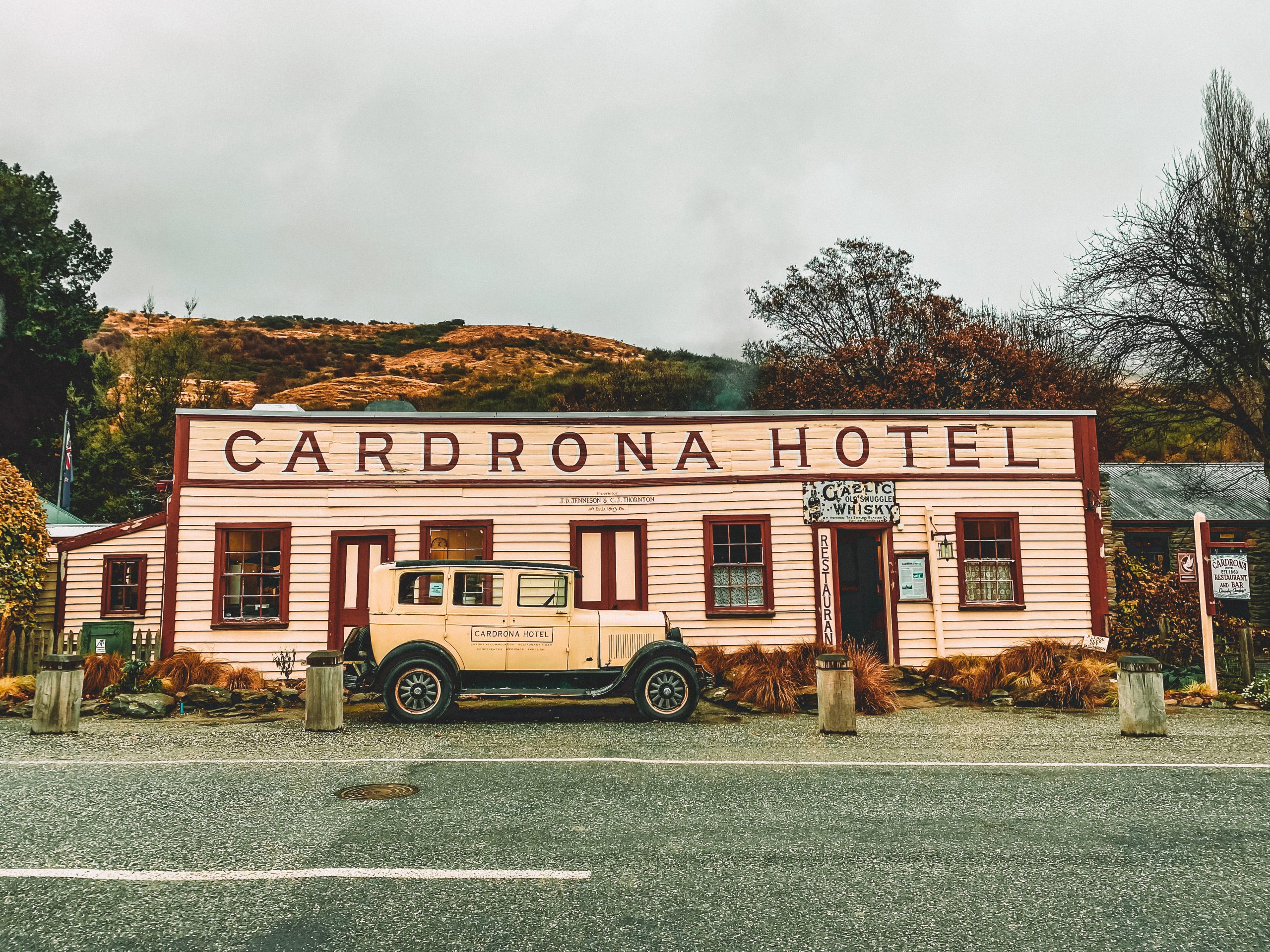
Once at Lake Wanaka, it’s a rite of passage to visit #ThatWanakaTree – a willow tree that sits alone in the water at the southern end of the lake.

There are some brilliant hikes around the Wanaka area, the best of them all being Roy’s Peak.
Within walking distance of Wanaka town centre you can go for a wine tasting at the highly rated Rippon Vineyard, whilst craft beer lovers may prefer Ground Up Brewing and Rhyme X Reason Brewery.
After you leave Wanaka and continue north, don’t miss the stunning Blue Pools Track in Mount Aspiring National Park.
Stop 26: Fox Glacier & Franz Josef Glacier
After checking out Blue Pools, it’s time to head through the Haast River Valley towards Glacier Country (maybe stopping off at Thunder Creek Falls if you have time).
Franz Josef Glacier & Fox Glacier are on the opposite side of the Southern Alps to Mount Cook.
Found on the ‘Wild West Coast’ of New Zealand, they are surrounded by untamed natural wilderness and rainforests.
My first suggestion would be to drive to the Fox Glacier Lookout for an appetiser, and then drive to the town of Franz Josef / Waiau to get up close to the ice.
A short drive from town brings you to the Franz Josef Glacier Walk, a brilliant 1.7km return walk that rewards you with glacier views.

The walk through the Franz Josef Glacier Valley gives you the opportunity to see the retreating glacier and the rocky landscape left behind by the ice.
Franz Josef Glacier is another great location to do a Heli Hike.
Stop 27: Hokitika Gorge
Hokitika Gorge is a popular spot on the New Zealand road trip route due to its insanely blue water.
The gorge was ground out of granite by the Hokitika River, and the vibrant ‘milky’ turquoise colour is due to the fact that it’s fed by the glaciers and contains lots of rock flour.

A must do activity is the Hokitika Gorge Walk, a circular trail which takes you over the well-photographed suspension bridge and through the forests of the Hokitika Scenic Reserve
Stop 28: Abel Tasman National Park
*FYI, the drive between Hokitika Gorge and Abel Tasman is just over five hours, so if you want to break up this section of your New Zealand road trip, you could stop over at Lake Rotoroa or anywhere else on route.*
Abel Tasman National Park is one of the most beautiful places in New Zealand, described as a ‘coastal paradise’ with pristine white sand beaches and aquamarine ocean.

The area is most famous for the Abel Tasman Coast Track, a 60km track winding across beaches and through forests.
If you only want to do a short section of the walk, I would recommend exploring the area around the ‘Astrolabe Roadstead’, which is the channel of water between Adele Island and the mainland.
In this area you’ll find the highest concentration of white sandy beaches and blue water (if you can make it to Te Pukatea Bay, it’s amazing).
Even better, you don’t have to do a return walk, because there are water taxis to take you back to your car/ campervan once you’ve completed your section of the walk.
If you don’t like hiking, you could explore by kayak instead.

Stop 29: Nelson
Nelson is a cool city at the top of South Island, popular with art and music lovers.
From art galleries to gourmet food markets, Nelson is the perfect chilled out destination to finish your high-adrenaline New Zealand road trip.
History lovers may enjoy Founders Heritage Park, a replica historic village telling the story of European settlement in Nelson.
Foodies will love the Nelson Saturday Market, along with the highly rated Hopgoods Restaurant and Hawker House.
Nelson is also located on Tasman’s Great Taste Trail, a network of cycleways passing through vineyards, fruit stalls, fish and chip shops and the famous Pic’s Peanut Butter Factory.
Just outside of Nelson you’ll find ‘The Centre of New Zealand’, a monument on a hilltop that marks the geographical centre of the country.
I hope you’ve enjoyed the Ultimate New Zealand Road Trip Itinerary – make sure you give yourself at least a month to do this trip in order to see everything this beautiful country has to offer.
You don’t need to spend a night at every stop on this New Zealand road trip itinerary. Places like Matakana, Hobbiton Movie Set, Christchurch, Glenorchy, Arrowtown & Nelson only require a couple of hours to explore. Meanwhile, you may want to stay a couple of nights in places like Rotorua, Lake Taupo, Mount Cook and Queenstown because there is loads to do and see.
